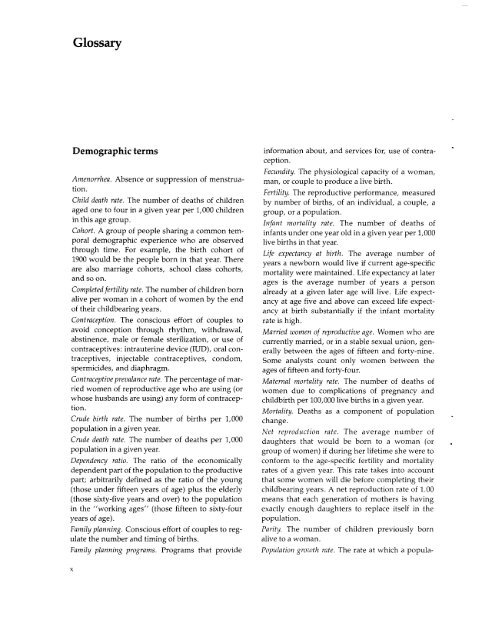World Development Report 1984
World Development Report 1984
World Development Report 1984
You also want an ePaper? Increase the reach of your titles
YUMPU automatically turns print PDFs into web optimized ePapers that Google loves.
Glossary<br />
Demographic terms information about, and services for, use of contraception.<br />
Fecundity. The physiological capacity of a woman,<br />
Amenorrhea. Absence or suppression of menstrua- man, or couple to produce a live birth.<br />
tion. Fertility. The reproductive performance, measured<br />
Child death rate. The number of deaths of children by number of births, of an individual, a couple, a<br />
aged one to four in a given year per 1,000 children group, or a population.<br />
in this age group. Infant mortality rate. The number of deaths of<br />
Cohort. A group of people sharing a common tem- infants under one year old in a given year per 1,000<br />
poral demographic experience who are observed live births in that year.<br />
through time. For example, the birth cohort of Life expectancy at birth. The average number of<br />
1900 would be the people born in that year. There years a newborn would live if current age-specific<br />
are also marriage cohorts, school class cohorts, mortality were maintained. Life expectancy at later<br />
and so on. ages is the average number of years a person<br />
Completed fertility rate. The number of children born already at a given later age will live. Life expectalive<br />
per woman in a cohort of women by the end ancy at age five and above can exceed life expectof<br />
their childbearing years. ancy at birth substantially if the infant mortality<br />
Contraception. The conscious effort of couples to rate is high.<br />
avoid conception through rhythm, withdrawal, Married women of reproductive age. Women who are<br />
abstinence, male or female sterilization, or use of currently married, or in a stable sexual union, gencontraceptives:<br />
intrauterine device (IUD), oral con- erally between the ages of fifteen and forty-nine.<br />
traceptives, injectable contraceptives, condom, Some analysts count only women between the<br />
spermicides, and diaphragm. ages of fifteen and forty-four.<br />
Contraceptive prevalance rate. The percentage of mar- Maternal mortality rate. The number of deaths of<br />
ried women of reproductive age who are using (or women due to complications of pregnancy and<br />
whose husbands are using) any form of contracep- childbirth per 100,000 live births in a given year.<br />
tion. Mortality. Deaths as a component of population<br />
Crude birth rate. The number of births per 1,000 change.<br />
population in a given year. Net reproduction rate. The average number of<br />
Crude death rate. The number of deaths per 1,000 daughters that would be born to a woman (or<br />
population in a given year. group of women) if during her lifetime she were to<br />
Dependency ratio. The ratio of the economically conform to the age-specific fertility and mortality<br />
dependent part of the population to the productive rates of a given year. This rate takes into account<br />
part; arbitrarily defined as the ratio of the young that some women will die before completing their<br />
(those under fifteen years of age) plus the elderly childbearing years. A net reproduction rate of 1.00<br />
(those sixty-five years and over) to the population means that each generation of mothers is having<br />
in the "working ages" (those fifteen to sixty-four exactly enough daughters to replace itself in the<br />
years of age). population.<br />
Family planning. Conscious effort of couples to reg- Parity. The number of children previously born<br />
ulate the number and timing of births. alive to a woman.<br />
Family planning programs. Programs that provide Popuilation growth rate. The rate at which a popula-<br />
x









